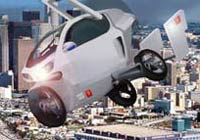Hybrid car on three wheels flies like a bird high in the sky
After many years of pioneering with well-known parties as the Dutch Aerospace Laboratory (NLR) to create a flying and driving vehicle John Bakker has formed a management team and is recruiting employees to start PAL-V Europe. A number of investors have been found to back the start-up and currently initiatives are taken towards more investors to speed up market launch.

John Bakker has invested 6 years of his time in developing a vehicle concept that can fly as well as drive: PAL-V (Personal Air and Land Vehicle). A dream Henry Ford already had when he built the first car. This will be a revolution in door to door mobility in the near future. In countries with underdeveloped infrastructure it means safe and faster transportation but also in developed countries it will safe people lots of time.
On the ground, the slim line, aerodynamic 3-wheel vehicle is as comfortable as a luxury car. But has the agility of a motorbike, thanks to its patented cutting-edge ‘tilting’ system. The single rotor and propeller are folded away until the PAL-V is ready to fly.
Airborne, the PAL-V flies under the 4,000 feet (1,500 m) floor of commercial air space. With land and air space reaching capacity, this is some of the last free space.
The PAL-V is highly fuel-efficient and powered by an environmentally certified car engine. It can run on petrol like a conventional car but can also run on biodiesel or bio-ethanol. It can reach speeds of up to 200 km/h both on land and in the air.
To propel the PAL-V in the sky, a single rotor and propeller are used, similar to what would be found in a gyrocopter. The distance required for takeoff is 50 meters and landing space is even less, allowing the PAL-V to be operated in many environments. With a maximum airspeed of 120 mph and no traffic to contend with, commuting times with a PAL-V should be reduced considerably.
Powering the PAL-V is a Mazda-sourced, environmentally certified automotive engine capable of running on gasoline as well as bio-diesel or bio-ethanol. According to the company, Special Light Sport Aircraft certification, a Sports Aviation License, motorcycle license, and standard automobile driver's license are all required for operation of the vehicle in the U.S.
It all seems a little too good to be true at this stage, but we'd love to be able to check out a PAL-V in the flesh. Undoubtedly, personal air/land transport will be a viable prospect for the multitudes at some point down the line, motortrend.com reports.
Soon private flying will no longer be the exclusive domain of executives and celebrities. If infrastructure does not exist or congestion or obstacles block the destination – fly. If the weather is too bad to fly – drive. Driving and flying combined in one vehicle that could cost little more than an executive saloon car.
John Bakker cooperated 6 years with well-known partners to develop the PAL-V concept. It is a combination of proven technologies. It fits within the new certification constraints and regulations that are in place since 2005 in the US and Europe.
Next to John Bakker the management team now consists of Robert Dingemanse who has championed several successful product launches and business start-ups at Philips Electronics and Jim Emanuels of Tacstone, specialised in starting up new businesses. This team has the right skills and experience to turn the concept into a business success, technologynewsdaily.com reports.
Source: agencies
Prepared by Alexander Timoshik
Pravda.ru
Subscribe to Pravda.Ru Telegram channel, Facebook, RSS!


